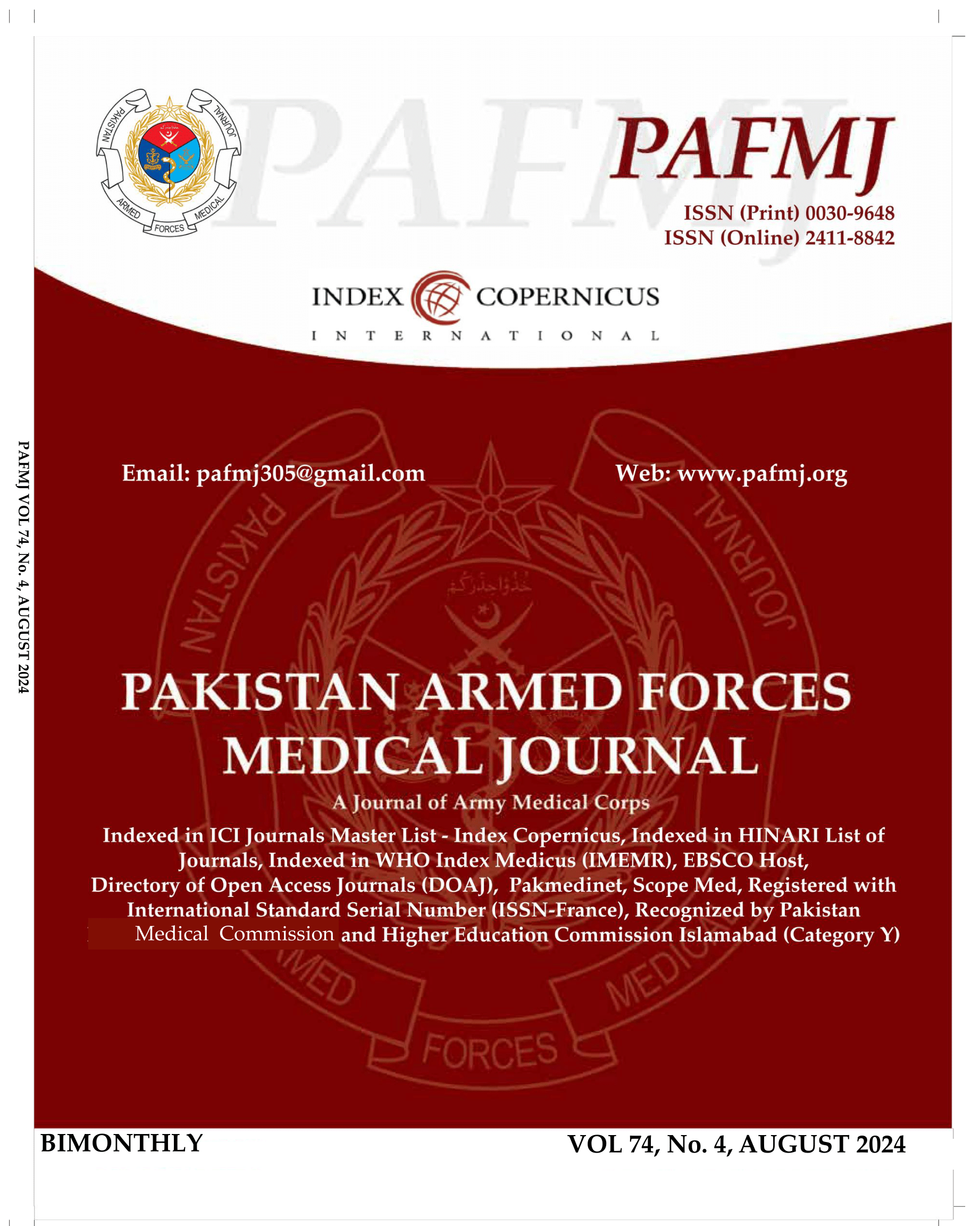Thyroid Dysfunction Secondary to Endocrine Disruptive Chemicals – A Systematic Review
DOI:
https://doi.org/10.51253/pafmj.v74i4.12181Keywords:
Endocrine Disruptors, systematic Review, thyroid Hormone, thyroid Diseases.Abstract
Objectives: To assess the epidemiological data and potential connection between different endocrine chemical disruptors and thyroid hormone abnormalities.
Study Design: The 2020 PRISMA standards were followed when conducting the systematic review. Ten research studies were found and examined after an in-depth review of the scientific literature.
Methodology: The systematic review was aimed to gather all pertinent information, including observational studies (prospective or retrospective cohorts) that address the relationship between exposure to endocrine disruptors and thyroid hormone imbalance.
Results: Ten studies were found, and they demonstrated that these substances, especially in adulthood, impact the level of thyroid hormone and the incidence of thyroid nodules.
Conclusions: Endocrine disruptive chemicals can compromise thyroid function by affecting hormone transporters, gene expression, and the hypothalamic-pituitary-thyroid axis.
Downloads
References
Tonelli FCP, Tonelli FMP. Causes and Effects of Pesticide and Metal Pollution on Different Ecosystems. In: Bioremediation and Biotechnology, Vol 2. Springer International Publishing; 2020.
Sokal A, Jarmakiewicz-Czaja S, Tabarkiewicz J, Filip R. Dietary Intake of Endocrine Disrupting Substances Presents in
Environment and Their Impact on Thyroid Function. Nutrients 2021; 13(3): 867. https://doi.org/10.3390/nu13030867
Diamanti-Kandarakis E, Bourguignon JP, Giudice LC.
Endocrine-Disrupting Chemicals: An Endocrine Society Scientific Statement. Endocrine Rev 2009; 30(4): 293-342.
https://doi.org/10.1210/er.2009-0002
Monneret C. What is an endocrine disruptor? Comptes Rendus Biologies 2017; 340(9-10): 403-405.
https://doi.org/10.1016/j.crvi.2017.07.004
Darbre P. Overview of air pollution and endocrine disorders. Int J Gen Med 2018; 11: 191-207.
https://doi.org/10.2147/IJGM.S102230
Kumar M, Sarma DK, Shubham S. Environmental Endocrine-Disrupting Chemical Exposure: Role in Non-Communicable Diseases. Front Public Health 2020; 8: 553850.
https://doi.org/10.3389/fpubh.2020.553850
Petrakis D, Vassilopoulou L, Mamoulakis C. Endocrine Disruptors Leading to Obesity and Related Diseases. Int J Environ Res Public Health. 2017; 14(10): 1282.
https://doi.org/10.3390/ijerph14101282
ATSDR. Toxicological Profile for Cadmium. In: ATSDR’s Toxicological Profiles. CRC Press; 2002.
Klaassen CD, Liu J, Diwan BA. Metallothionein protection of cadmium toxicity. Toxicol App Pharmacol 2009; 238(3): 215-220. https://doi.org/10.1016/j.taap.2009.03.026
Liu J, Qu W, Kadiiska MB. Role of oxidative stress in cadmium toxicity and carcinogenesis. Toxicol Appl Pharmacol 2009; 238(3): 209-214. https://doi.org/10.1016/j.taap.2009.01.029
Jancic SA, Stosic BZ. Cadmium Effects on the Thyroid Gland. In: Vitamins and Hormones. Volume-94. Academic Press; 2014.
Babić Leko M, Gunjača I, Pleić N, Zemunik T. Environmental Factors Affecting Thyroid-Stimulating Hormone and Thyroid Hormone Levels. Int J Mole Sci 2021; 22(12): 6521.
https://doi.org/10.3390/ijms22126521
Jugan ML, Levi Y, Blondeau JP. Endocrine disruptors and
thyroid hormone physiology. Biochem Pharmacol 2010; 79(7): 939-947. https://doi.org/10.1016/j.bcp.2009.11.006
Vandenberg LN, Ågerstrand M, Beronius A. A proposed framework for the systematic review and integrated assessment (SYRINA) of endocrine disrupting chemicals. Environ Health. 2016; 15(1): 74. https://doi.org/10.1186/s12940-016-0156-6
Perrier L, Adhihetty C, Soobiah C. Examining semantics in
interprofessional research: A bibliometric study. J Interprofessional Care 2016; 30(3): 269-277.
https://doi.org/10.3109/13561820.2016.1142430
Cristofoli D, markovic J. How to make public networks really work: a qualitative comparative analysis. Public Admin 2016; 94(1): 89-110. https://doi.org/10.1111/padm.12192
Munn Z, Moola S, Riitano D, Lisy K. The development of a critical appraisal tool for use in systematic reviews addressing questions of prevalence. Int J Health Policy Manag 2014; 3(3): 123-128. https://doi.org/10.15171/ijhpm.2014.71
Blanco-Muñoz J, Lacasaña M, López-Flores I. Association
between organochlorine pesticide exposure and thyroid hormones in floriculture workers. Environ Res 2016; 150: 357-363. https://doi.org/10.1016/j.envres.2016.05.054
Yorita Christensen KL, Carrico CK, Sanyal AJ, Gennings C. Multiple classes of environmental chemicals are associated with liver disease: NHANES 2003–2004. Int J Hygiene Environ Health 2013; 216(6): 703-709. https://doi.org/10.1016/j.ijheh.2013.01.005
Derakhshan A, Shu H, Peeters RP. Association of urinary bisphenols and triclosan with thyroid function during early pregnancy. Environ Int 2019; 133: 105123.
https://doi.org/10.1016/j.envint.2019.105123
Wang X, Wang L, Zhang J. Dose-response relationships between urinary phthalate metabolites and serum thyroid hormones among waste plastic recycling workers in China. Environ Res 2018; 165: 63-70. https://doi.org/10.1016/j.envres.2018.04.004
Przybyla J, Geldhof GJ, Smit E, Kile ML. A cross sectional study of urinary phthalates, phenols and perchlorate on thyroid hormones in US adults using structural equation models (NHANES 2007–2008). Environ Res 2018; 163: 26-35.
https://doi.org/10.1016/j.envres.2018.01.039
Zani C, Magoni M, Speziani F. Polychlorinated biphenyl serum levels, thyroid hormones and endocrine and metabolic diseases in people living in a highly polluted area in North Italy: A population-based study. Heliyon 2019; 5(6): e01870.
https://doi.org/10.1016/j.heliyon.2019.e01870
Deziel NC, Alfonso-Garrido J, Warren JL, Huang H, Sjodin A, Zhang Y. Exposure to Polybrominated Diphenyl Ethers and a Polybrominated Biphenyl and Risk of Thyroid Cancer in Women: Single and Multi-Pollutant Approaches. Cancer Epidemiol Biomarker Prev 2019; 28(10): 1755-1764.
https://doi.org/10.1158/1055-9965.EPI-19-0526
Hoffman K, Lorenzo A, Butt CM. Exposure to flame retardant chemicals and occurrence and severity of papillary thyroid cancer: A case-control study. Environ Int 2017; 107: 235-242.
https://doi.org/10.1016/j.envint.2017.06.021
Huang H, Sjodin A, Chen Y. Polybrominated Diphenyl Ethers, Polybrominated Biphenyls, and Risk of Papillary Thyroid Cancer: A Nested Case-Control Study. Am J Epidemiol 2020; 189(2): 120-132. https://doi.org/10.1093/aje/kwz229
Sheikh IA, Beg MA. Structural studies on the endocrine-disrupting role of polybrominated diphenyl ethers (PBDEs) in thyroid diseases. Environ Sci Pollution Res 2020; 27(30): 37866-37876. https://doi.org/10.1007/s11356-020-09913-8
Downloads
Published
Issue
Section
License
Copyright (c) 2024 Ambreen Gul, Sarah Saleem, Faizan Munir, Aashi Ahmed, Anwar Bibi, Sadia Naeem

This work is licensed under a Creative Commons Attribution-NonCommercial 4.0 International License.















